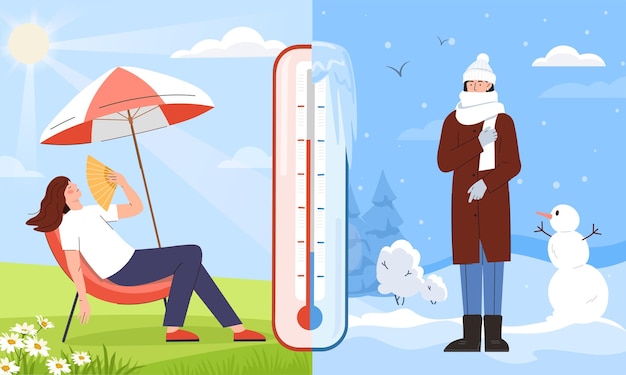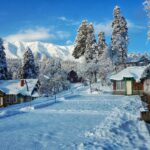Have you ever wondered why some places, like Canada or Antarctica, are always cold, while others, like India or Dubai, stay hot almost all year?
It’s not just about being far or near. The Earth is full of surprises, and the weather depends on many things like where you live, how high you are, and even how the Earth moves.
Let’s break it down in very simple words so everyone can understand.
🌍 It All Starts with the Sun
The main reason for hot and cold weather is the sun. The sun gives us heat and light, but it doesn’t shine on every place the same way.
Imagine a ball with a flashlight shining on it. The middle part (the “equator”) gets the light directly, while the top and bottom (the “poles”) get less light at an angle. That’s exactly how the Earth works.
🧭 1. Where You Are on Earth (Latitude)
The Earth is like a giant ball. We divide it with imaginary lines called latitudes. The most important ones are:
- Equator (middle)
- Tropics (near the middle)
- Poles (top and bottom)
🌞 Near the Equator – Always Hot
Places near the equator, like Singapore, Brazil, Kenya, get direct sunlight all year. So they are hot almost all the time, and they don’t have much of a winter season.
❄️ Near the Poles – Always Cold
Places near the North Pole (like Alaska, Greenland, or Siberia) and South Pole (like Antarctica) get slanted sunlight. This means the sunlight has to travel through more atmosphere and spreads out. So, they don’t get much heat and stay cold most of the year.
⛰️ 2. How High You Are (Altitude)
The second reason is altitude — that means how high the land is from sea level.
🏔️ Higher Places = Colder Weather
Even if a place is near the equator, it can still be cold if it’s high up in the mountains. For example:
- Mount Kilimanjaro is near the equator, but it has snow on top!
- Shimla and Manali in India are colder than Delhi, even though they’re not far apart.
Why? Because the higher you go, the colder it gets. The air gets thinner, and it can’t hold heat well.
🌊 3. Oceans and Water Bodies
Water affects weather a lot. Places near oceans, seas, or big lakes often have milder temperatures.
🌴 Coastal Areas Stay More Balanced
- Mumbai, India, is hot, but not as extreme as Nagpur, which is far from the sea.
- The ocean keeps temperatures more steady — not too hot, not too cold.
But if cold water currents are nearby (like in Peru or California), even coastal areas can become cool.
🌬️ 4. Wind and Air Currents
The air doesn’t stay still. It moves around the Earth. These are called wind patterns or air currents.
- Cold air moves from the poles toward the equator.
- Warm air moves from the equator toward the poles.
Sometimes this air brings cold weather to a hot place, or hot weather to a cool place. For example:
- Europe is not too cold in winter because of warm air from the Atlantic Ocean.
- Northern India can feel cold when cool winds come from the Himalayas.
🔁 5. Earth’s Tilt and Seasons
The Earth is not straight. It’s tilted at an angle of about 23.5 degrees. Because of this, different parts of the Earth get different amounts of sunlight at different times of the year.
This creates seasons:
- Summer – when your part of the Earth faces the sun.
- Winter – when your part faces away.
But places near the equator don’t feel much seasonal change. That’s why countries like Indonesia or Uganda stay hot all year.
Places far from the equator, like Canada or Russia, have extreme seasons — hot summers and very cold winters.
🌵 6. Deserts vs. Forests
Land type also matters.
- Deserts heat up quickly in the day and cool down fast at night. That’s why Rajasthan or Sahara Desert can be very hot during the day and freezing at night.
- Forests and green areas keep temperatures more stable because trees trap moisture and block direct sunlight.
🏙️ 7. Cities vs. Villages
This may surprise you — big cities are often hotter than nearby villages. Why?
Because cities have more:
- Buildings
- Roads
- Vehicles
- Factories
These all trap heat and make the area warmer. This is called the urban heat island effect.
🌎 Real Examples
Let’s compare two places:
❄️ Greenland (Cold All Year)
- Near the North Pole
- Covered in ice and snow
- Sunlight is weak and slanted
- Result: Cold all year
☀️ Singapore (Hot All Year)
- Right on the equator
- Low altitude
- Gets direct sunlight
- Result: Hot and humid all year
🤔 Why Should We Care?
Understanding why places are hot or cold helps in many ways:
- Travel planning
- Farming and food growing
- Disaster preparedness
- Clothing choices
- And even understanding climate change
As the Earth warms due to human activities, some places may become hotter, drier, or wetter than before.
🌤️ Final Thoughts
The world is full of different climates — from burning deserts to icy mountains. The temperature of a place depends on many things like where it is, how high it is, how close it is to water, and how the Earth moves.
So next time you feel cold or hot, just remember — the Earth has its own system. And it’s all thanks to the sun, air, water, and land working together.


